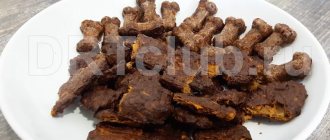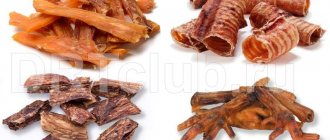I have 2 dogs living at home - a dachshund named Rustem and a mongrel Shurik - a male I picked up on the street. Both pets are very picky about food. They, of course, love dog treats, but they are expensive. That’s why I most often prepare delicious treats for them myself. And what they like most about my cooking is jerk chicken. This is inexpensive and low-fat meat, it is not harmful to animals and they really like it. Now I will share with you the recipe.
Recipes
Currently, there are a considerable number of treats that can be prepared for a dog at home:
Liver cookies
To make this food for your pet, you need to mix chicken liver (500 grams) with oatmeal (3 tablespoons). If there are no such flakes, you can use rolled oats.
Two chicken eggs and a little garlic are also added to the resulting mass. The mixture is crushed using a blender or meat grinder. It should turn out homogeneous. The product is spread on a baking sheet in one layer, and then sent to the oven to bake for one hour. At the end, the finished cookies are cut into small pieces.
Crackers
To prepare them, it is better to use rye bread . It is cut into small rectangular pieces and placed in the oven for 10–15 minutes. If you do not want to use the oven, then you can simply leave the product to sit in the open air for 2-3 days.
How and what to feed your dog
Despite their undoubted benefits, the share of these products in a dog’s diet should not exceed 15%. It is enough to give your dog offal twice a week. You can feed your dog tripe daily, but in small portions.
Liver
This filter organ neutralizes toxins entering the body, but does not store them. Therefore, liver can be safely given to your pet. This product is a source of vitamins A, group B, folic acid, and iron.
Vitamin A is a powerful antioxidant, it improves digestion and has a beneficial effect on the reproductive system. Folic acid and vitamin B12 support the health of the nervous system, improve brain and vascular function. Iron increases endurance, participates in the formation of hemoglobin, brain functioning, metabolism, and saturation of cells with oxygen.
The liver is especially useful for rapidly growing young dogs, as well as for preparing breeding dogs for mating and for feeding lactating bitches.
When exposed to high or low temperatures, the nutrient content decreases, so it is preferable to feed dogs raw liver. However, sometimes worm larvae are found in it. To avoid infection, the liver is either boiled or frozen. This product can be fed to animals in its raw form only after a veterinary check.
The share of liver in the diet should not exceed 5%. Exceeding the dosage leads to digestive disorders.
Lung
This organ contains a significant amount of connective tissue, has low calorie content, small amounts of protein and is poorly digested. The lungs do not bring significant benefits to the dog's body. To avoid vomiting, they are introduced into the diet gradually, boiled and crushed. It is better to combine lungs with other offal.
Heart
This is a source of antioxidant and immunomodulator coenzyme Q10, which is necessary for cell activity and inhibits the aging process. The organ contains selenium, zinc, phosphorus, as well as B vitamins and amino acids, which help build muscle mass, produce and store energy, and increase endurance.
Heart contains twice as much collagen and elastin as regular meat, which is important for joint health. It is similar in structure to muscle meat, but heavier and denser. Dogs are safely fed raw hearts.
Kidneys
This offal is rich in vitamins A, K, B, E, zinc, iron, as well as fatty acids that improve the condition of the coat and skin. Including kidneys in the menu normalizes the functioning of the digestive system. Before feeding, it is better to cut them in half lengthwise, soak them in cold water and give them raw to the dog.
The organ is rich in vitamins, but it has a lot of connective tissue and fat, so portions should be small. The udder is perfectly digestible, including it in the diet helps build muscle and adapt to increased loads. There is less fat in the milk udder. Raw udder with milk is given to puppies after 3 months, after removing excess fat. This product is also useful for nursing and pregnant dogs.
Brain
The by-product contains lipids and choline. This is an easily digestible food that allows you to nutritiously feed exhausted animals during the rehabilitation period after illness and male dogs during the mating period. Brains are cooked with rice or buckwheat.
Spleen
This organ contains a large amount of complete protein and iron. In terms of amino acid content, the spleen is close to muscle meat and liver. It is given to dogs boiled.
A large amount of spleen in a dog’s diet leads to black diarrhea and other digestive disorders.
Tripe, abomasum
These are the most valuable parts of the stomach, rich in enzymes, protein, amino acids, and beneficial microflora that help digest food. Enzymes also improve metabolism, cleanse the blood, neutralize toxins, and strengthen the immune system. The stomach is very beneficial for the health of the dog, despite its specific unpleasant odor.
Before feeding, the abomasum and rumen are cleaned of remnants of semi-digested food and washed under running water. Because During heat treatment, enzymes are destroyed; dogs are given a raw stomach, cut into pieces.
Ears, legs, tails
These by-products are not rich in protein, but they contain calcium, phosphorus and serve as a good exercise machine for dog jaws. Leg tendons are rich in elastin and collagen. The skin is a source of amino acids and trace elements. Dogs love to chew on these foods, raw or cooked.
Some owners boil beef legs, lips, ears, and tails for 3-4 hours. The result is a rich broth, which when cooled turns into jellied meat. This dish can be given to puppies from one month of age.
Heads and cartilaginous by-products
The trachea, diaphragm, kaltyk, and epiglottic cartilages contain a lot of protein and are rich in collagen and elastin. The trachea and diaphragm can be given to your dog quite often. They are useful for strengthening the muscles of the jaws, teeth and gums. These giblets are inexpensive and require no processing other than freezing for three days. Before feeding, they are scalded with boiling water. The mucus contained inside the cartilage by-products sometimes leads to digestive upset. Therefore, they accustom the dog to this food gradually, starting with a small amount.
Skinned heads also contain protein. The heads are valuable for their calcium content. They are chopped into large pieces and boiled for 2-3 hours. After this, the meat is separated and fed to the dogs along with the broth. Leftover boiled skull bones should not be given to animals.
The benefits of homemade treats
You can buy ready-made treats in pet stores, but it is difficult to say for sure whether they are safe for your pet. Unscrupulous manufacturers may use different additives, sometimes without even listing them on the packaging. Ingredients may also be used that are harmful to the pet or simply not beneficial. Making homemade delicacies will give you complete confidence in what they consist of.
Special mention should be made of dogs with allergies. It can be expressed in intolerance to one product or even an entire list. In such a situation, it is quite difficult to select a finished product. Even a thorough study of the composition will not guarantee that the risk of an allergic reaction is excluded. For these pets, the only safe option is homemade treats.
Possible reactions
Some pets cannot tolerate offal and entrails even in small quantities. Food intolerance to offal is manifested by vomiting, diarrhea, irritation on the skin of the face, paws, ears, front legs, armpits, and around the anus. Sometimes skin or ear infections, red spots, hair loss, and constant scratching occur. There is no point in treating food allergies; it is enough to exclude allergens from the diet - chicken or meat by-products.
conclusions
The delicacy is easy to make, stores well, but is not suitable for training, because... cannot be broken or cut into small pieces. Therefore, it is suitable where you can reward the dog for a lot of work at the end with a large piece (for example, PSS and mentrailing, when he found an extra).
You can also take it with you on a hike to feed your dog (it stores well). Or you can just pamper your dog!
PS And next time I’ll tell you how to make delicious cookies for dogs!
Author of the article: Alexandra Bondarenko https://UmnayaDobaka.rf/
Other recipes for treats for training:
If you liked the recipe, check out these other dog treat recipes:
Liver.
Boiled liver usually does not cause problems. Raw food will most likely lead to disorders. On the market you can often be offered fascioliasis liver at a cheap price. Externally, it differs from normal in the presence of round holes penetrating the liver tissue. If a healthy liver has only a few rather large cord holes of natural origin, then fasciolosis (Fascioliasis is a helminthic disease of cattle) is all dotted with both large and small passages. Large passages have walls made of healed yellow tissue. In general, if there is a mass of any cord passages and holes in the liver, from very small to large, this is the so-called “dog” liver (this is what sellers call diseased livers that are fed to dogs). Fascioliasis is not dangerous for a dog, and nothing bad will happen if you feed your dog such liver, only boiled! It is possible to remove the affected area - more for aesthetic reasons than out of necessity.
Beef lips, ears
- why not! But not every dog will agree to taste them raw. If you want to cook, feed!
Beef heads
will have to cook. They are hardly a valuable product, but if you are willing to separate the crumbs of meat from small and sharp bones, it is your own choice. The same goes for beef legs. Honestly, if the budget is tight, then this is the solution: you cook a small portion of rice with a lot of hooves, and feed your dog normally.
How to give treats correctly
As a reward, a tidbit can be given only after performing a trick or command. You can use the treat as a snack, but this should not be done often. This is especially true for dried and dried offal. They are recommended to be used no more than 2-3 times a week and in limited quantities. Important! For small breed dogs, rewarding with food during training can be an alternative to one meal or half a serving. Giving the same treat during training and just like that is not worth it. This will break the logical chain in the pet’s head, and he will begin to think that it is not necessary to do something to get a tasty bite. If you want to give your dog treats just like that, you should use products for this purpose that are different from those used in training.
At what age and how often should you feed your dog offal?
You can offer your puppy chicken necks starting from three months. But, it is advisable to beat them first with a meat hammer so that the bones are softer. And until the puppy learns to chew and not swallow the necks whole, be sure to feed them under supervision.
Other types of tripe can be given to four-legged animals from 5-6 months, starting with small pieces.
If you observe intolerance or disorders when your dog eats any of the by-products, you should eliminate it for a while and then gradually add it to the diet in small portions.
It is especially useful to feed your pet tripe in the winter, since the vitamin D present in offal protects the dog’s body from inflammatory, infectious and colds.
Dried treats
The simplest dried treat is crackers. They are prepared in the oven from rye bread. You can sprinkle the pieces with a little oil before drying. Not all dogs love bread, but those who do will like this dried treat.
By drying at a low temperature, you can also prepare tasty treats from such products as:
Drying time depends on the capabilities of the oven and the nature of the product used. Most often, the process lasts from 1.5 to 3 hours. You can also use a microwave for drying, if it has such a function. Dried fruits, which are prepared in a special dryer, are also given as dried treats. Such goodies are very good for teeth, especially for puppies. You can also entice your pet with a tasty morsel for a while to go about its business.
A tasty dried piece will distract your pet and keep him occupied for a while
Beneficial features
Giblets contain more nutrients than regular meat. Firstly, offal is a source of animal protein, which is a building material for any organism.
Secondly, they are rich in microelements: phosphorus, iron, copper, magnesium, iodine, potassium, zinc, selenium.
Thirdly, these products contain a large amount of B vitamins, folic acid, vitamins A, K, E. In terms of vitamin D content, by-products have no equal among other feeds. This vitamin is one of the most important for living beings. Its deficiency leads to muscular dystrophy, fractures, malignant tumors, rickets, autoimmune, and infectious diseases. Offal is especially useful for dogs living in northern areas with few sunny days. In the cold season, when vitamin D deficiency is most likely, offal is included in the menu.
Fourthly, meat by-products, just like fish, contain healthy fatty acids Omega-3 and Omega-6 - sources of energy for cells.
Giblets contain little fat and carbohydrates, so they can be considered a dietary product.
By-products and muscle meat from animals raised on natural feed are much more nutritious and healthier than those fed on mixed feed.
Lungs, heart, trachea, liver, diaphragm and other tripe are significantly cheaper than meat. By including them in the diet, owners reduce the cost of maintaining a pet.
Teeth cleaning
When thinking about the question of whether it is possible to give chicken necks to a dog, it is very useful to take into account the fact that with the help of this product you can even massage the gums, which is very beneficial for the animal. Accordingly, intensive teeth cleaning occurs. If you give chicken necks regularly, you can generally prevent the occurrence of unpleasant symptoms. Subsequently, your pet will not be at risk of tartar or any problems associated with the oral cavity.
As a result, some processes even accelerate, for example, a faster replacement of milk teeth with permanent ones. An attentive owner really begins to notice visible changes.
Advantages of the purchased product
Cooking beef lung is a very troublesome and time-consuming task. But if you don’t have the opportunity to mess around in the kitchen, then you can buy dried lung, specially prepared for dogs. This food has many advantages. It is prepared under industrial conditions from parts of the carcass that have undergone intensive veterinary testing.
For preparation, a special dryer and special drying modes are used to preserve the maximum amount of useful substances.
The structure of the feed is light and porous. It is perfect for oral care, satisfies the dog’s natural need to chew something, strengthens the jaws, prevents the formation of tartar, and protects against gum disease and periodontitis.
Suitable for all dogs: young, elderly, puppies, overweight.
DIY dog treats
How to make healthy dried dog treats with your own hands? NO way unless you have high-quality equipment that will not only dry the goodies, but also destroy all germs and parasites. Improper drying will make such food harmful to your dogs, so we do not recommend that you give your pet bones that have been dried “in the sun.”
If you want your dog to eat homemade food and even his snacks to be healthy, then choose products from the VipVkus online store! All dog treats are made by the hands of our professionals, wonderful guys who adore dogs. What a coincidence!
We have been involved in dog training for a long time and many years ago we were thinking about how to create dry dog treats ourselves, for our dogs. Initially, we didn’t even think about turning this into a business! However, after studying the prices of modern drying equipment, we realized that buying it only for your dogs is unprofitable. Therefore, we decided to please all the dogs of our country with inexpensive and high-quality goodies!
You need to order dried treats in any quantities right now, before the warehouse is completely empty and we don’t have to get up to the machine again. Call now!
We recommend
Liver. packaging 0.50 gr.
Mini-steaks made from beef liver are the best treat for animals who always want to stay in good condition.. 90 rub.
Beef trachea 8 cm.
Beef trachea 8 cm. (3 pcs per pack) Beef trachea is a tube consisting of cartilage and connective tissue.. 90 rub.
Reviews
Gennady, Moscow
“I give my Yorkie chicken or turkey necks not so much for food, but for entertainment, to chew on instead of a bone. 4-5 pieces at a time, of course, not every day. Also chicken gizzards and heart. I also occasionally indulge in beef liver. Toda is ready to give everything for her.”
Tatiana, Volgograd
“The dachshund regurgitates the kaltyk back, the rest - the heart, lung, tripe - eats perfectly. I make small crackers from chicken liver: boil them, dry them in the oven, then cut them into cubes. An ideal treat for training."
Elena, Rostov-on-Don
“I often buy offal for my husky at the market. I also give Rick chicken hearts and navels, although they are not cheap. I mix it with rice or buckwheat, but sometimes the porridge remains, and the cunning guy chooses the meat.”
I propose to talk today about what foods can be given to a dog and, in general, whether they should be present in the diet of our pets. Still, the main component in the diet of dogs is muscle meat. But besides this product, any toothy “wolf cub” will happily eat such parts of prey as heart, lung, tripe, and so on. What role do offal (offal, tripe) play in feeding? Are they good for dogs, and how often should you offer them to your pet?
How to dry meat at home
In ancient times, drying was one of the most effective ways to stockpile meat. If a successful hunter brought large prey (for example, deer or elk), they tried to process a significant part of the carcass so that the meat did not spoil and was stored as long as possible. If the technological conditions were strictly observed, the process was safe and provided quite decent taste qualities of the finished product.
The modern housewife does not need to solve everyday problems familiar to her distant predecessors. Today, dried meat is considered a delicious delicacy that is easy to prepare even for a beginner who is not too experienced in culinary wisdom. Our article is addressed to those who want to learn how to properly dry meat.
Selection of raw materials and precautions
You can dry beef, horse meat, goat meat, lamb and even pork, as well as poultry (chicken, duck, turkey) and various game. For preparations of this kind, only low-fat raw materials are suitable, preferably taken from adult animals. To dry meat, choose dense muscle tissue (for example, tenderloin); From poultry carcasses, breasts are most often used for processing. Some experts are skeptical about the possibility of drying pork. The fact is that the density of pig meat is lower and the fat content is higher than, for example, beef or horse meat, which does not have the best effect on the fermentation process itself. In addition, pork is much more often infected with worm eggs, which can survive in the finished delicacy.
To avoid health problems, you need to understand the following. During the drying process, the meat is not subjected to heat treatment. The only protection against dangerous diseases in this case is salt, which inhibits the vital activity of pathogens. Of course, products sold by official sellers undergo sanitary inspection, but this does not mean that the possibility of pathogenic organisms in them is completely excluded. If you decide to dry the meat yourself, scrupulously follow all the technology requirements (especially salting times) and do not purchase raw materials from random suppliers.
What are by-products: what parts of the carcass
When it comes to beef, by-products include:
- Pical meat is the glands: thymus, salivary glands, pancreas, tonsils, ovaries;
- Trimmings from heads, including the sublingual cut;
- Flank, hem;
- Internal organs: liver, heart, spleen, kidneys, lungs, tripe, mesh, book, rennet, brains;
- Udder, testes;
- Bones and cartilage: beef tails, lips and noses, bovine penis, ears, kaltyk (part of the trachea).
Tripe for dogs
Pieces of trachea
If we are talking about poultry (chicken, turkey), then in addition to hearts and liver, gizzards are highly valued. Dogs can also be given raw chicken heads (after removing the beak), chicken legs and necks.
Turkey necks
Meat drying process
After you have salted the meat using one of the three methods suggested above, proceed to drying. The first stage is coating the salted pieces with spices. The spice mixture is prepared to taste. It may include various types of ground peppers (necessarily hot red pepper is a natural preservative), sweet paprika, coriander, star anise or mustard seeds, cumin, cloves, cumin, juniper berries, dried garlic and any herbs. Seasonings are evenly ground and the mixture is rubbed onto pieces of meat.
The raw materials are wrapped in gauze (each piece separately) and placed in a clean, dry container. The meat should lie in the refrigerator for at least 1 week, then it is taken out and rubbed again with a mixture of spices. Each piece is wrapped in clean gauze and tied with strong thread so that it can be hung.
To create optimal fermentation conditions, raw materials must be kept in a dry, cool and well-ventilated place at an optimal temperature of 4 to 25 ℃ (up to 40 ℃ is acceptable). Important: do not dry the meat in the sun.
For poultry, the process is completed in a few days (maximum a week), but to completely cure strips of beef or horse meat, it will take from 2 weeks to 1 month. During the cold season, it is best to hang meat on a balcony or ventilated loggia. You can even spread a small amount of raw materials on the kitchen window (with the window always open), but so that the pieces do not touch each other.
Those who often dry meat themselves make portable dryers that have special slats or grates for hanging raw materials. During the warm season, you should not keep the product outdoors: it may deteriorate from the heat or be damaged by flies. In the summer, it is better to cook meat directly in the refrigerator, hanging small pieces between shelves or placing them directly on wire racks (in which case they will have to be turned frequently).
How to dry meat in an electric dryer
To dry meat, you can use an oven and dryer. With an electric dryer, organizing the process is easier. In this case, the raw material is immediately cut into slices no more than 1 cm thick. The pieces are kept for about 1 hour in a marinade prepared from vegetable oil, soy sauce, lemon juice, sugar, mustard and spices (the ingredients are mixed in an arbitrary ratio, as you like). The meat is then placed on dryer trays and processed at maximum convection at a temperature of 60 ℃ for 6-8 hours (the slices must be turned over in the middle of the process). The finished product is quite soft, but, according to experts, the taste is much inferior to air-dried meat.
We invite you to watch a video in which the owner tells how he makes jerky at home (drying small pieces of pork and turkey) using an electric dryer.
Dried lung for walking
The light delicacy does not stain your hands at all, is cheap, healthy and can be stored for a long time.
Beef lung is cut into small pieces, taking into account the size of the pet, as well as the fact that during the cooking process they will decrease by 3-4 times. It is more convenient to freeze the lung before slicing. The baking sheet is covered with parchment, which is greased with vegetable oil (it is difficult to peel off the foil) and the pieces are laid out on top. Next they are dried in the oven at 180°C. The degree of shrinkage depends on the dog's preference. You just have to take into account that the pieces that are damp inside are stored in the refrigerator, and “crackers” can be stored at room temperature in a cereal jar.
Storing jerky
Storing dried meat requires maximum protection from moisture. Therefore, it is best to place the finished product in a tightly sealed container.
Jerky can be frozen. It will last 10-12 months in a sealed bag.
The pieces can be wrapped in parchment or transferred with paper napkins, which will absorb the condensation that appears. In this form, the meat can be stored in the refrigerator for up to 6 months. If you seal the product in airtight bags and then put it in the freezer, it will retain its flavor and aroma and will remain usable for a year.
Our article is specifically about drying meat at home. In this sense, pork is not the most suitable product (jamon, for example, you can’t make at home): it is more often than other types of meat contaminated with “all sorts of nasty things.” This means that very careful salting is required to minimize risks. In addition, pork is much softer and fattier than the meat of other animals and rots more quickly. It turns out that it is unsafe to process it without heating and without a very large amount of salt. Do you know why religions that originally originated in hot countries are against eating pork? This is an ancient sanitary norm that turned out to be so important that it degenerated into a religious dogma. The point is not that pigs cannot be raised in the desert (they live and breed anywhere). It is important that their meat immediately begins to deteriorate in the heat, which is fraught with severe poisoning.
We hope that our tips on how to dry meat will be useful to you. Please share your experience in the comments.











